Other Guides
In this article
Data Analyst vs. Business Analyst Roles: How to Choose
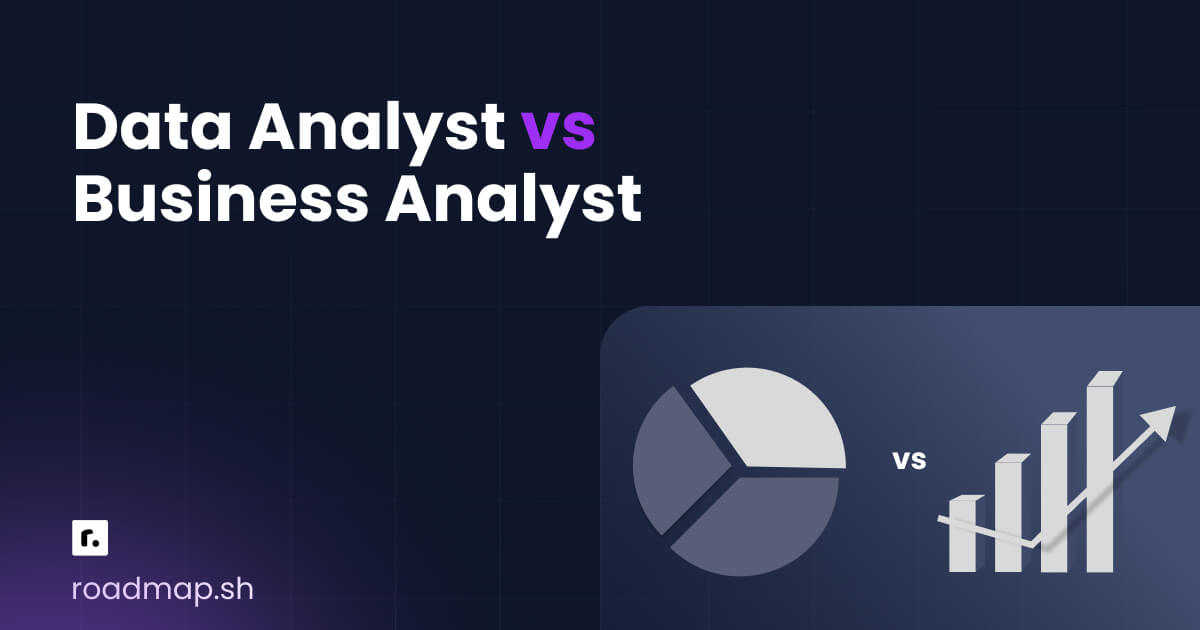
If you love working with raw data and uncovering patterns, a data analyst role might be the best fit for you. In this role, you'll build predictive models and analyze data to identify trends. You'll also create data visualizations that help communicate meaningful insights to managers, team leads, and other important team members, allowing them to make informed decisions.
However, if you're someone who enjoys using data insights to inform strategic business decisions and working with various teams to achieve company goals, pursuing a career as a business analyst may be a better choice. You'll work with stakeholders to understand business problems, develop ideas to address them, and achieve growth and success.
TL;DR: Choosing between business and data analyst roles
Focus:
Data: Data analysis, problem-solving, communicating findings.
Business: Business analysis, problem-solving, facilitating collaboration.
Skills:
Data: Programming languages (Python, R, SQL), data analysis, statistical knowledge.
Business: Communication, problem-solving, business acumen.
Best career path for:
Data: Those who enjoy working with data, identifying trends, and creating insights.
Business: Those who enjoy working with stakeholders, identifying business needs, and implementing solutions.
Salary range:
Varies based on experience, location, and industry, but generally competitive for both data analysts and business analysts.
This guide provides an overview of both data analyst and business analyst fields, the needed skills, and the opportunities you can expect. By the end, you'll know which career path suits you best based on your interests, skills, and goals.
Data analyst vs. business analyst: What are the key differences?
The table below breaks down the main differences between data analyst and business analyst roles to help you understand which one might be a better fit for you:
Category | Data Analyst | Business Analyst |
|---|---|---|
Focus | Extracting insights from data | Understanding business objectives and solving business problems |
Typical output | Reports, dashboards, visualizations, analysis findings, presentations, and statistical or predictive models | Business requirements documents (BRDS), process flow diagrams, user stories, solution recommendations, and presentations and reports |
Key tools | Programming languages (Python, R, SQL), data analysis tools (Microsoft Excel), and data visualization tools (Tableau) | Project management tools (Jira), requirements gathering tools (Google Docs), process modeling tools (Lucidchart), spreadsheet tools (Microsoft Excel), and presentation tools (PowerPoint) |
Skills | Data manipulation, statistical analysis, data cleaning, data mining, data modeling, data visualization, analytical thinking, and communication | Stakeholder management, requirements elicitation and documentation, business acumen, business process improvement and modeling (BPMN), critical thinking, negotiation, presentation skills |
Collaboration | Works with data engineers, data scientists, business analysts, product managers, and other technical teams | Works with stakeholders, project managers, developers, quality assurance (QA) analysts, data analysts, and end-users |
Educational path | Bachelor’s or Master’s in fields like Data Science, Statistics, Mathematics, Computer Science, Economics | Bachelor’s or Master’s in Business Analytics, Information Technology, Finance, or Economics; professional certifications like CBAP. |
Career path | Junior Data Analyst → Data Analyst → Senior Analyst → Specializations: Data Scientist, Data Engineering, Machine Learning Engineer, Analytics Lead | Junior Business Analyst → Business Analyst → Senior Analyst → Specializations: Project Manager, Product Manager, Business Architect |
Coding required? | Yes | No, but knowing some coding basics can be helpful |
Salary range | Varies based on experience, location, and industry | Varies based on experience, location, and industry |
How do the roles differ in focus and responsibilities?
Data analysts and business analysts have very different responsibilities and focuses. As a data analyst, your primary focus will be on extracting insights from raw data. Your main goal will be to transform data into actionable insights that help others to understand what's happening and make informed decisions.
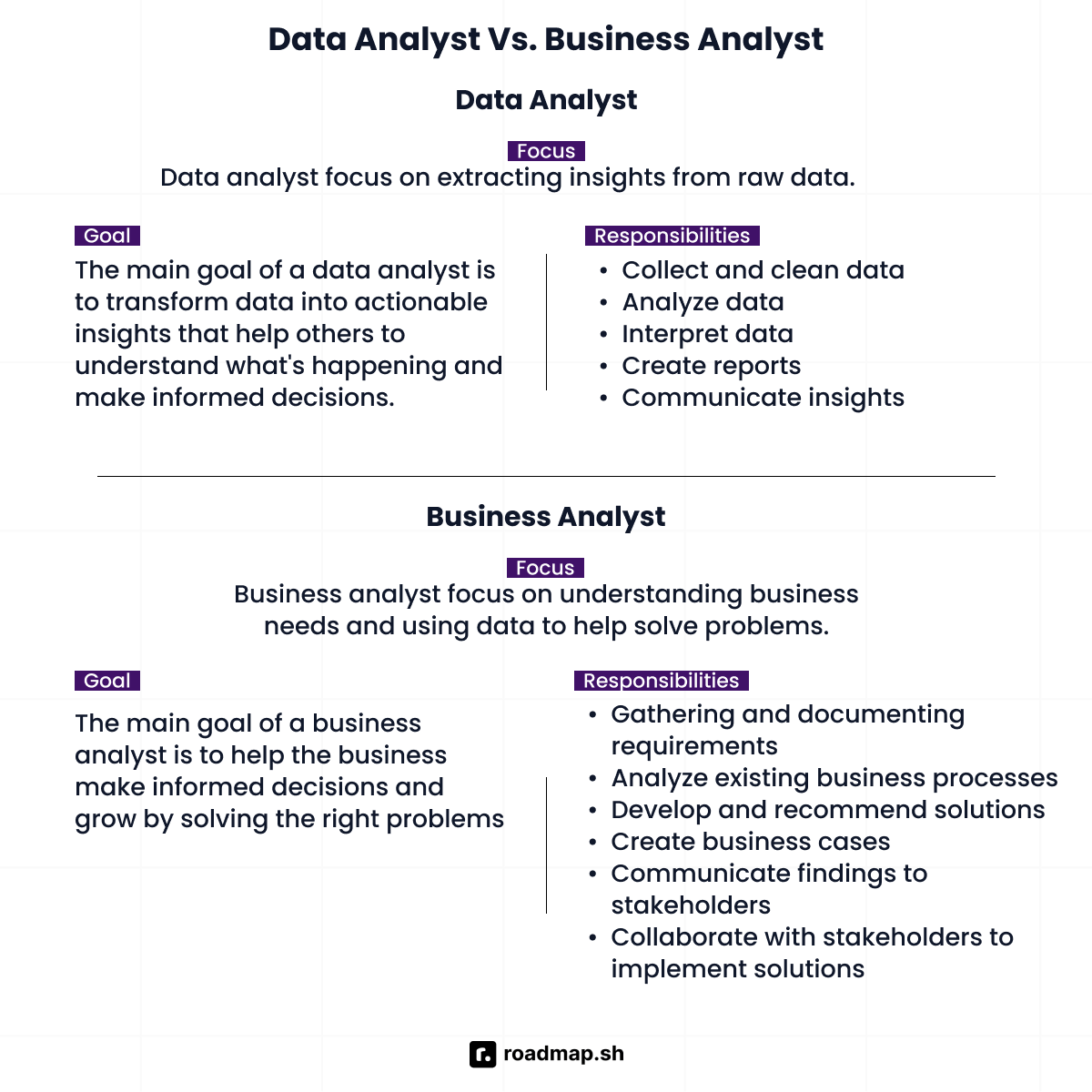
Your responsibilities as a data analyst will include:
Collecting and cleaning data: Collecting and cleaning data from various sources, such as databases (using SQL), to prepare it for analysis.
Analyzing data: Use data analytics languages and tools, such as Python, to analyze data and identify trends and patterns.
Interpreting data: Interpreting data findings and generating actionable recommendations.
Creating reports: Creating reports and visualizations to communicate findings.
Communicating insights: Communicating findings and recommendations to stakeholders (both technical and non-technical) to inform business decisions. You'll also work with teams, like data engineers, who help design and maintain data systems that support analysis.
On the other hand, a business analyst uses data insights to improve business outcomes. As a business analyst, you'll focus on understanding business needs and using data to help solve problems. Your main goal is to help the business make informed decisions and grow by solving the right problems.
Your responsibilities as a business analyst will include:
Gathering and documenting requirements: Understand what the business needs by chatting with stakeholders and jotting down clear requirements.
Process analysis: Analyze existing business processes to identify areas for improvement and remove inefficiencies.
Propose solutions: Develop and recommend solutions to address business needs, improve business operations, and achieve results.
Business case development: Create business cases using tools such as Microsoft Office (Excel for financial analysis, Word for documentation, and PowerPoint for presentations) to support solution proposals.
Stakeholder communication: Communicate findings and recommendations to stakeholders. Doing this will help confirm that the solution meets business needs and everyone is on the same page.
Implement solutions: Collaborate with stakeholders and technical teams to build and implement the solution.
A data analyst working at a supermarket might analyze historical sales data to identify which products customers tend to buy. This insight can help the marketing team create a targeted marketing campaign to promote those products. A business analyst working at the same supermarket could then use that insight to develop a business case for investing in more shelf space, for example, for those popular products, thereby increasing sales.
While there are some similarities between business analyst and data analyst roles, such as working with data, analyzing trends, and communicating insights, they apply their skills in different ways. Data analysts tend to focus more on the technical side of data, such as data mining and data cleaning. However, business analysts focus on the business side, such as identifying problems.
What does a typical day look like for each role?
A typical day for me as a data analyst is usually a mix of technical work and collaborative efforts. The majority of my time involves exploring, analyzing, and sharing data with other team members.
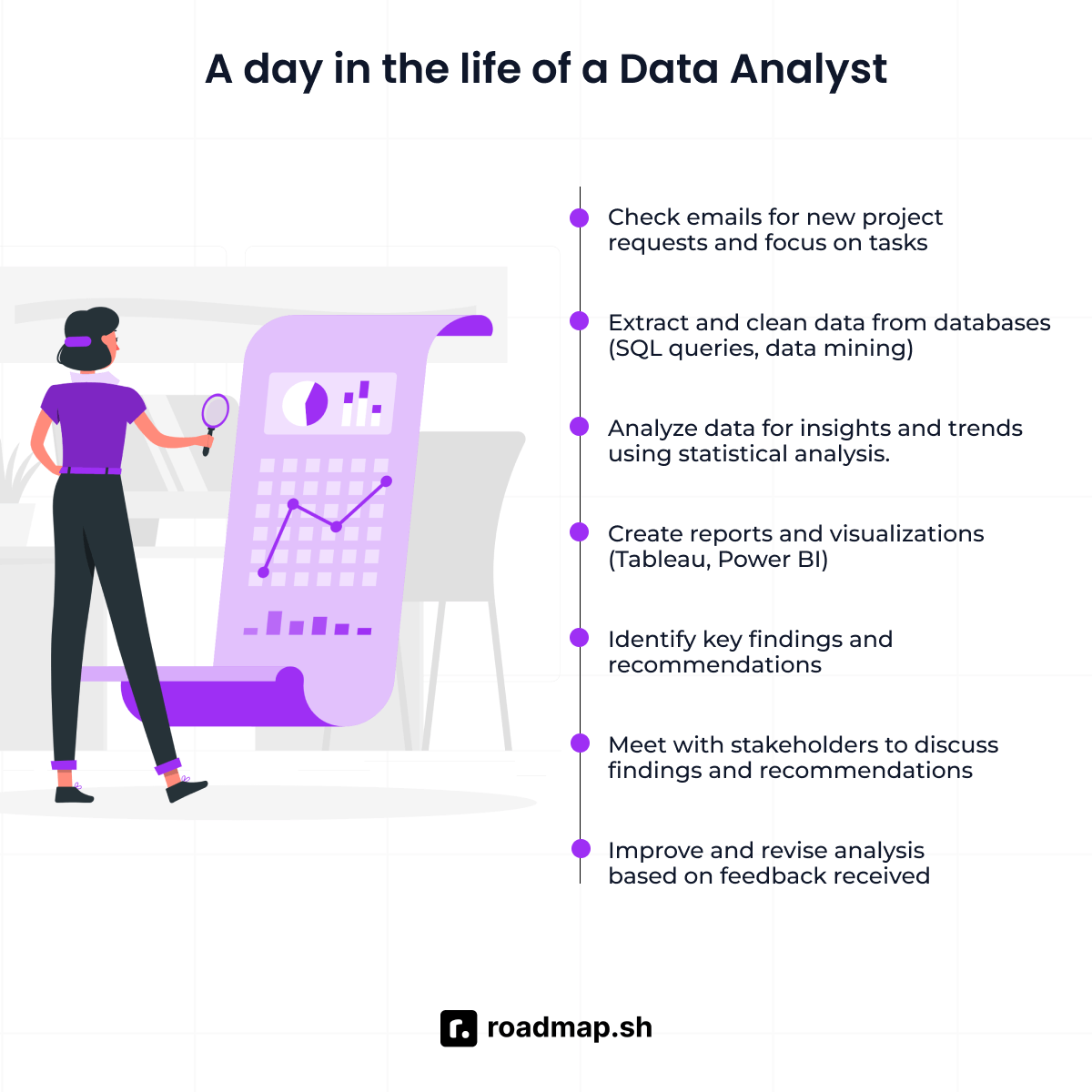
Your typical day as a data analyst might look like this:
9:00 AM: Check emails for new project requests.
9:30 AM: Extract, mining, and cleaning data from databases using tools like SQL.
11:00 AM: Analyze data for insights and trends using statistical analysis.
12:30 PM: Create reports and visualizations (Tableau).
2:00 PM: Identify key findings and recommendations.
3:30 PM: Meet with stakeholders to discuss findings and recommendations
4:00 PM: Improve and revise analysis based on feedback received.
You'll be doing most of the work yourself, like coding and creating statistical models for predictive purposes.
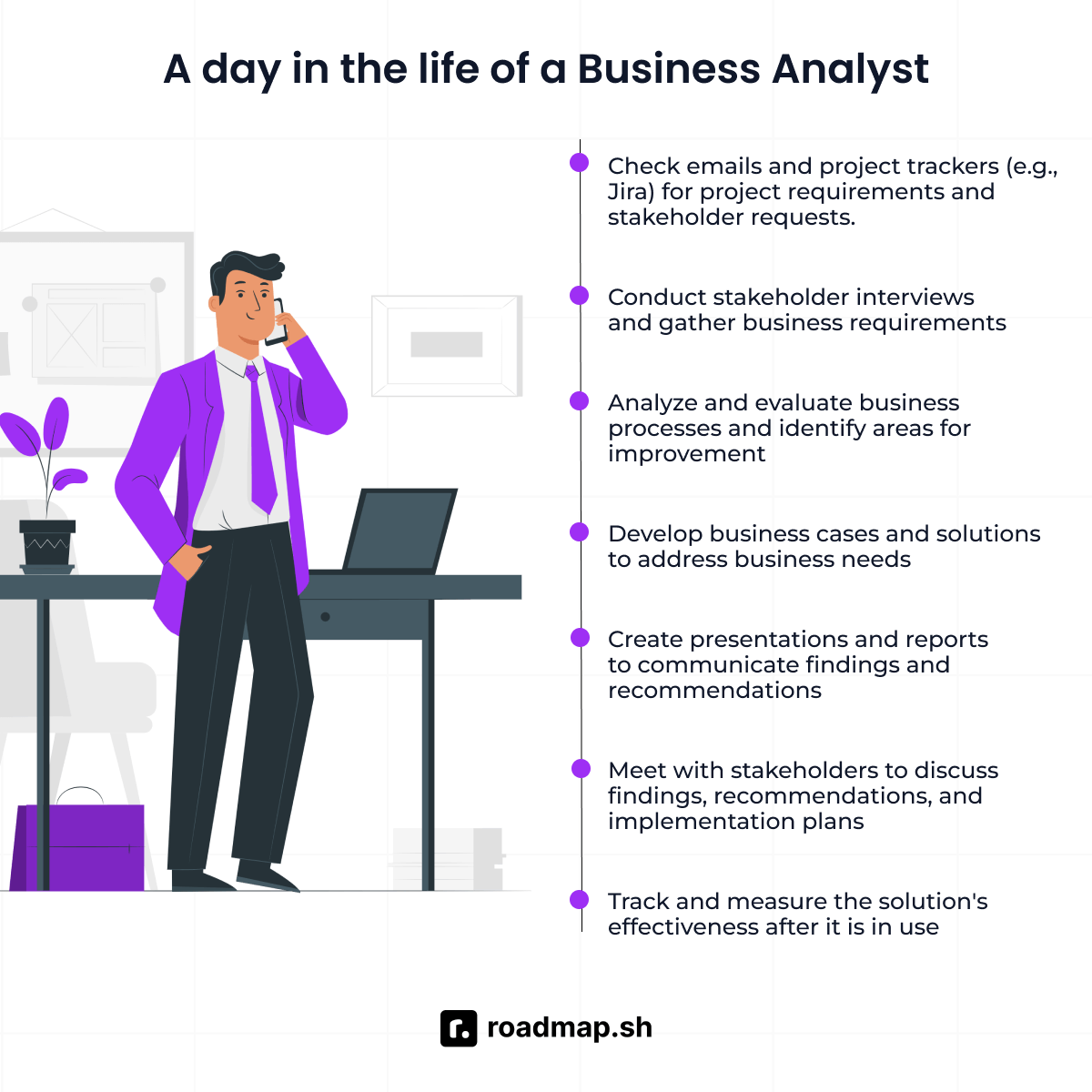
On the other hand, a business analyst spends their day understanding business needs, identifying issues, and coming up with ways to solve them. The following is what a typical day could be like for a business analyst:
9:00 AM: Check emails and project trackers (e.g., Jira) for project requirements and stakeholder requests.
9:30 AM: Conduct stakeholder interviews and gather business requirements.
11:00 AM: Analyze and evaluate business processes and identify areas for improvement.
12:30 PM: Develop business cases and solutions to address business needs.
2:00 PM: Create presentations and reports to communicate findings and recommendations.
3:30 PM: Meet with stakeholders to discuss findings, recommendations, and implementation plans.
4:00 PM: Track and measure the solution's effectiveness after it is in use.
Collaboration is central to this role. You'll work closely with developers, project managers, and other teams to deliver the right solutions and support business goals. Depending on the company’s needs, project scope, or available data, the tasks of a data analyst or business analyst can vary.
What skills do you need for each role?
It takes a combination of soft and technical skills to become a successful business analyst or data analyst. As a data analyst, you'll need the following skills:
Strong technical skills in using analytical tools like SQL, Python, and Excel.
Good at using data visualization tools like Tableau to present findings.
Excellent at cleaning data and preparing complex datasets for analysis.
Good problem-solving skills for handling data issues and finding logical solutions.
Excellent communication and presentation skills to communicate complex data concepts.
Good understanding of statistics and math to perform statistical analysis and build models.
Strong critical and analytical thinking skills to solve problems and find insights.
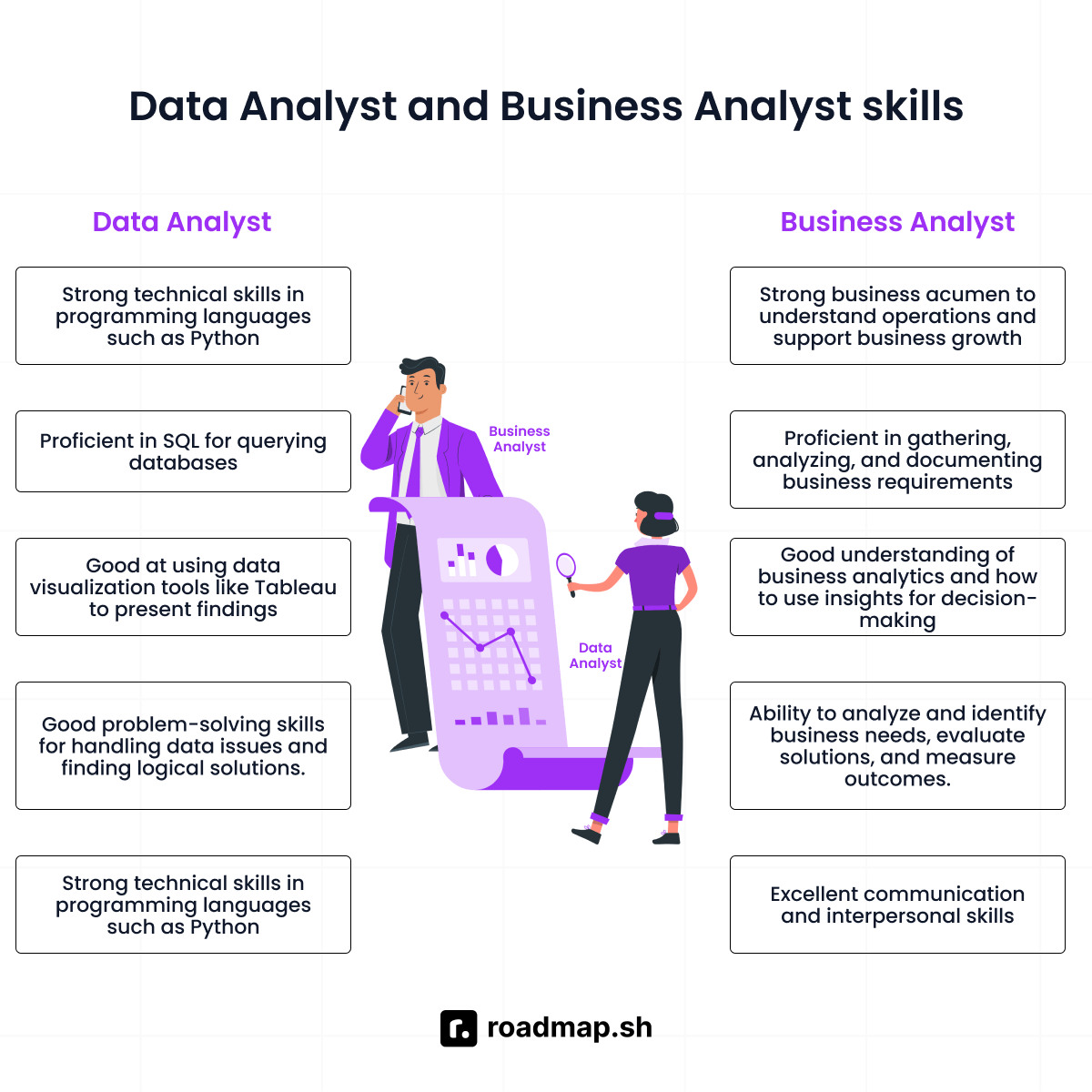
On the flip side, if you choose to be a business analyst, your skill set will focus more on understanding the business and its needs. To succeed as a business analyst, you'll need the following skills:
Strong business acumen to understand operations and support business growth.
Proficient in gathering, analyzing, and documenting business requirements.
Good at problem-solving and critical thinking for process improvement.
Excellent communication and interpersonal skills for collaboration.
Skilled in developing business cases to support business decisions and gain stakeholder support.
Good understanding of business process modeling to analyze and improve business operations.
Familiar with project management principles to support project planning and execution.
If you want to succeed in the job market as a business analyst, you'll need some technical skills, but not to the same extent as a data analyst. You should know a bit about how to code, but it's not a dealbreaker, especially for entry-level positions. Business analysts tend to focus on business operations and stakeholder management, rather than technical coding skills.
What’s the difference in salary and career growth?
Data analysts often earn more money than business analysts because their job requires more technical skills for data science, especially in advanced data analytics and predictive modeling.

Data analysts are in high demand in fields like finance, healthcare, and technology. If you pursue this path, you will specialize in areas such as data visualization, business intelligence, or product and marketing analytics. According to Indeed, entry-level data analysts earn an annual average salary of around $51,927 to $73,365. As you get more experienced, you can make a lot more money. Mid-career data analysts usually make between $80,000 and $90,000 a year, while senior data analysts can earn over $146,000.
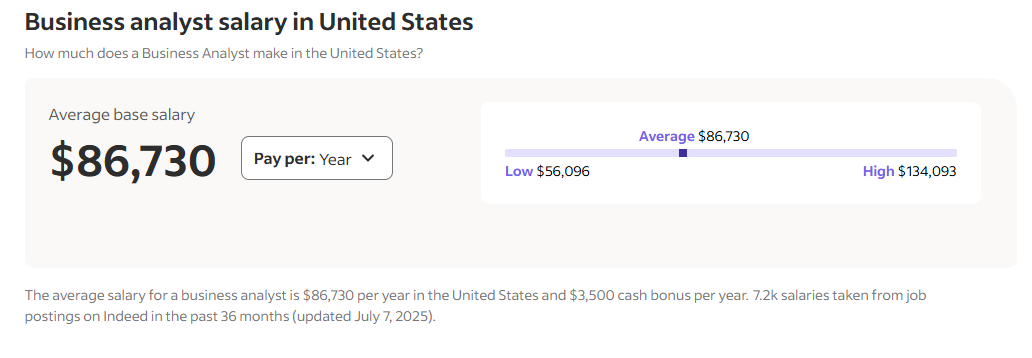
In contrast, business analysts are also sought after in industries such as finance, consulting, and IT. If you pursue this path, you may work as a requirements analyst, project manager, or product owner. According to Indeed, the annual average salary for business analysts ranges from $56,000 to $86,000, depending on location and industry. Like data analysts, salaries for business analysts can also grow with experience, reaching over $104,000 for senior roles.
Both roles have a good job outlook and offer opportunities for career growth and advancement. However, the role of a business analyst provides broader opportunities across various industries. As a business analyst, your skills are versatile! You can work in finance, healthcare, IT, retail, and many other sectors, using your skills in various settings. Data analysts, while also versatile, often work in industries that rely a lot on data, such as technology, finance, and market research.
How do the educational paths compare?
Data analysts excel in settings that prioritize quantitative analysis and technical skills. They typically pursue degrees and certifications that provide a solid foundation in mathematics, statistics, and data analysis. Some of the following are common educational paths for aspiring data analysts:
A bachelor's degree in Computer Science, Mathematics, Statistics, economics, or Data Science.
Master's degree in Data Science, data analytics, or related fields for senior roles (optional).
Online courses in data analytics, Excel, SQL, Python, and more.
Professional certifications such as Microsoft Certified: Data Analyst Associate.

On the other hand, as a business analyst, you'll learn about business strategy, communication, and analytical thinking during your education. Some of the following are common educational paths for aspiring business analysts:
A bachelor's degree in business administration, finance, economics, management, or related fields.
Master's degree in Business Administration (MBA), business analytics or related fields for senior roles (optional).
Professional certifications, such as Certified Business Analysis Professional (CBAP).
Online courses in requirements gathering, stakeholder management, process modeling, Excel, SQL, and more.
If you don't have a technical background, becoming a business analyst might be easier since it deals more with planning and solving business problems than with writing code. You can apply what you already know about how businesses operate, combined with further learning, and start your journey from there. However, data analysis requires more technical skills, so you may need extra training in programming languages and data analysis tools.
Also, you don't always need a traditional four-year degree to get started in either role. Many data analysts and business analysts get their skills through boot camps or online courses. roadmap.sh provides detailed guides on data science and SQL to help you learn.
How to decide based on your personality and interests
If you're still unsure about which path to take, here are some factors to help you decide:
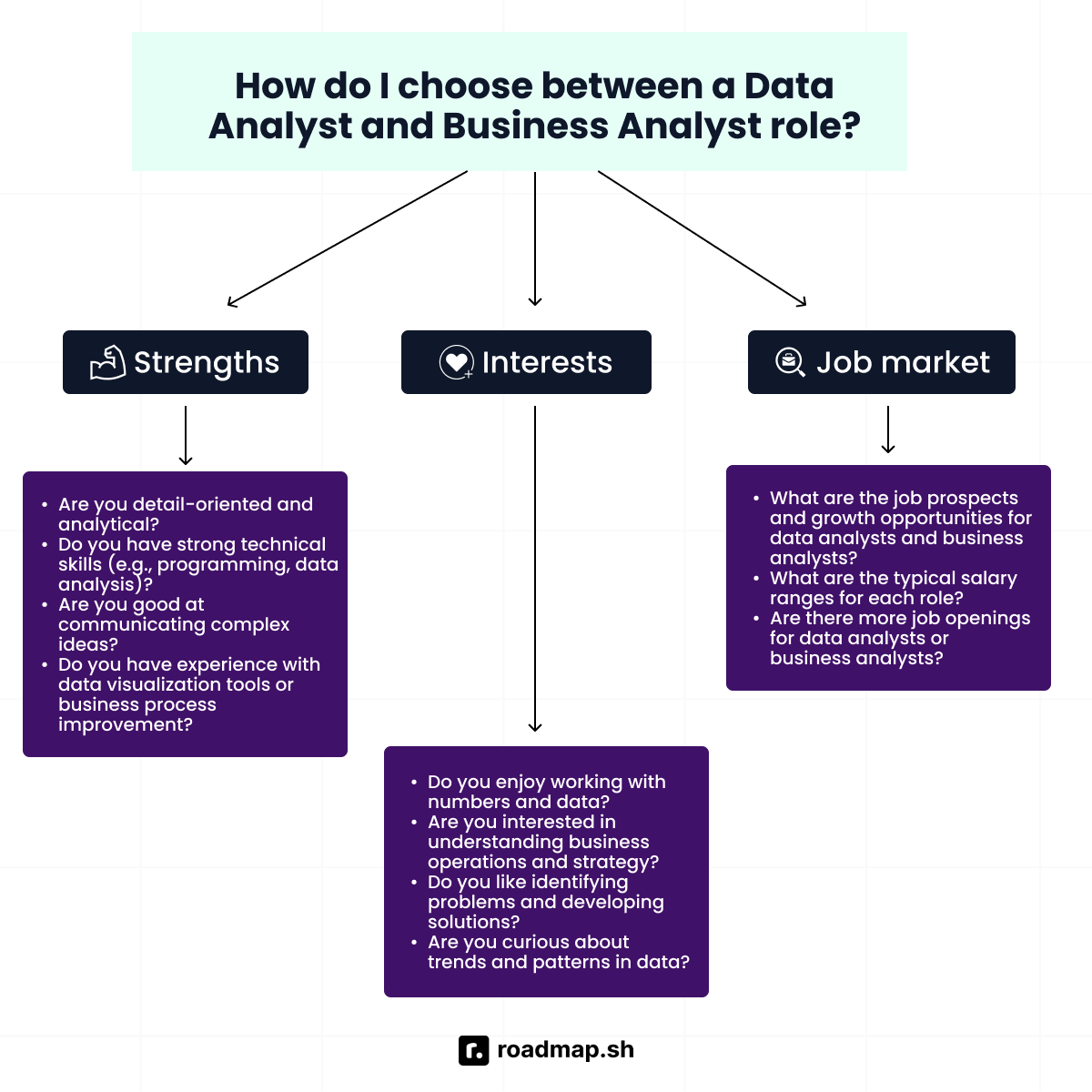
Know your interests
When deciding between becoming a business analyst or a data analyst, think about what you enjoy doing. Data analysts work with data to identify trends, create visualizations, and inform decisions. If you enjoy working with quantitative data, then the role of a data analyst may be a good fit for you.
On the other hand, business analysts work with stakeholders to understand business needs and come up with solutions. If you're into how businesses operate, enjoy working with people, and are good at communicating complex ideas, a business analyst might be a better fit for you.
Clarify your value
A data analyst provides the "what" and the "why" behind the data to guide better decision-making. If you enjoy working with data, answering the "what is happening?" and "why is it happening?" questions, this role is for you.
However, if you're interested in answering the "so what does this mean?" and ''what next should we do to improve it?" questions, consider becoming a business analyst.
Build a small project
If you are curious about becoming a data analyst, start by collecting data on a topic that you like. You can gather data on your expenses, savings, and more and then use tools like Excel or Python to analyze and visualize the data. Also, you can download a dataset from sources such as Kaggle or the UCI Machine Learning Repository to practice. Doing this will not only improve your practical skills but also give you a taste of what it's like to work with data.
However, if you are more interested in the business analyst path, look for a project that involves understanding business challenges. An example of this would be developing a business case for a hypothetical project or product. Identify the business stakeholders, requirements, and potential solutions. Use tools like Lucidchart for process mapping to help you assess the business needs.
Data analyst vs. business analyst FAQs
Which is better, data analyst or business analyst?
Neither is better than the other; it depends on your interests and skills. Choose any of the role that works best for you.
Can a data analyst become a business analyst?
Yes, a data analyst can become a business analyst. Many of the skills you learn as a data analyst are transferable, like analyzing and working with data to make decisions. To transition into the role, you need to improve your understanding of business operations and processes, as well as learn stakeholder management skills through additional training.
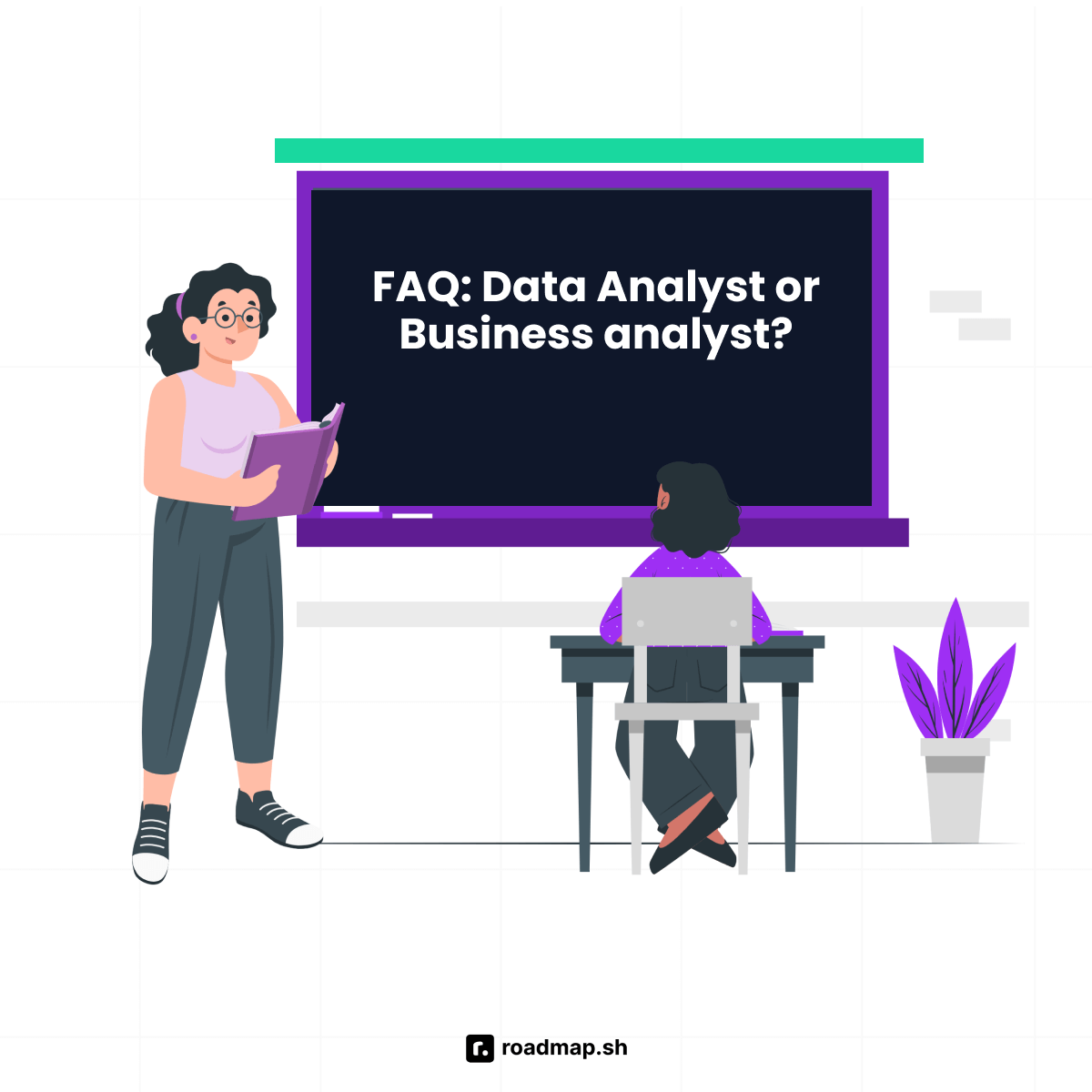
Is business analyst harder than data analyst?
Both are challenging in their ways; it's just a matter of perspective. If you prefer more interpersonal and strategic work, the role of a business analyst can be harder. However, the role of a data analyst can be harder for you if you prefer less technical work.
Do I need to be good at math to be a data analyst?
No, it's not compulsory to be very good at math to become a data analyst. However, you should have a basic understanding of math and statistics to work well with data.
What next?
Data analysts and business analysts use data to back decisions with facts, not guesses. Both roles offer good job opportunities and a positive job outlook, with opportunities to advance and progress in your career. By understanding what each role involves and the needed skills, you can select the path that best aligns with your interests and strengths.
Also, your career plans can always change. You might think that a data analyst is the role for you, but as you learn and grow, you might realize that you're more interested in being a business analyst. It's completely normal to feel unsure at first, and switching paths is a common part of the learning and improvement process. Don't be afraid to switch roles if you find that it's not the right fit for you.
For continuous learning, visit the roadmap.sh guides for resources on business analyst and data analyst roles. Both guides contain all the resources you need to start your learning journey.
 Ekene Eze
Ekene Eze